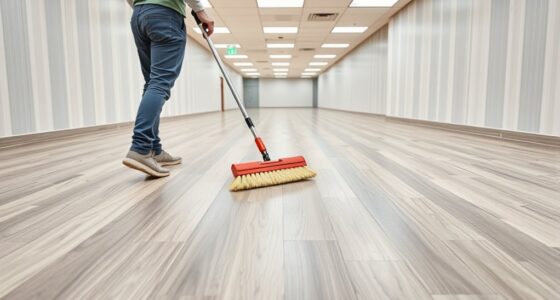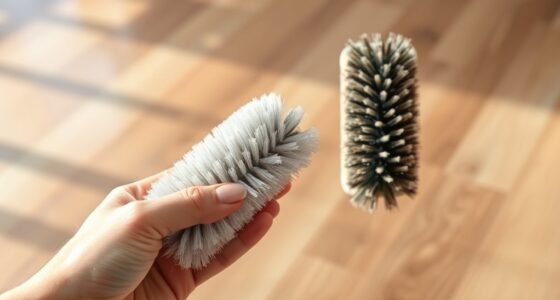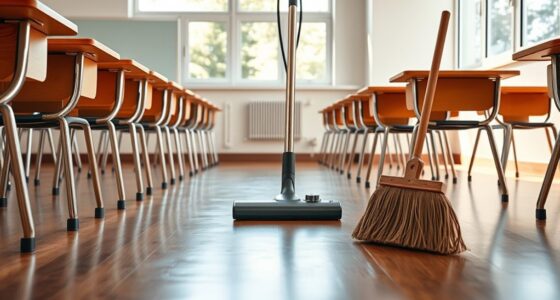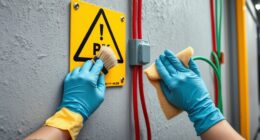To beat fine dust on concrete floors with a two-pass sweeping plan, start by using a high-quality broom or push sweeper to loosen and gather dust, focusing on edges and corners. Next, use microfiber dust mops or electrostatic cloths to remove remaining particles, ideally slightly dampened for better dust pick-up. Maintaining this routine helps prevent dust buildup and improves air quality. Keep exploring for more tips to keep your floors consistently clean and dust-free.
Key Takeaways
- Implement a two-pass sweeping strategy: first loosen and remove dust, then capture residual fine particles effectively.
- Use high-quality brooms or push sweepers for thorough initial cleaning, focusing on edges and textured areas.
- Follow with microfiber dust mops or electrostatic cloths, slightly dampened, to pick up remaining fine dust without redistributing it.
- Incorporate air purifiers during cleaning to trap airborne dust and prevent resettling.
- Establish a consistent routine, emphasizing regular two-pass sweeps to maintain cleaner, healthier concrete floors.
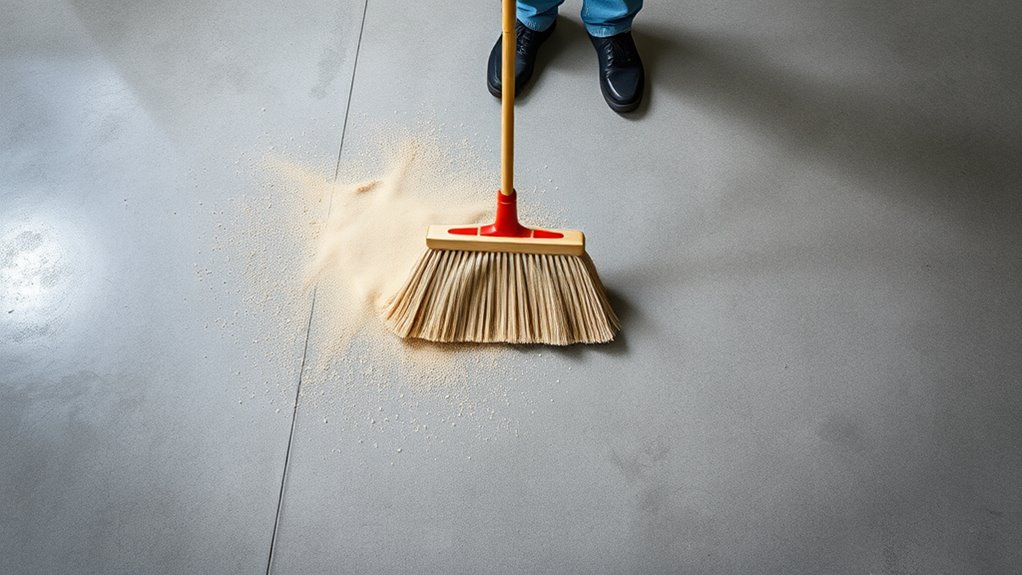
Are you tired of constantly battling fine dust settling on your concrete floors? If so, you’re not alone. Fine dust particles are stubborn and tend to settle quickly, making it a challenge to keep your floors looking clean. Fine dust can also be a source of allergens and respiratory irritation, especially for sensitive individuals. The key to effective dust control lies in adopting a strategic cleaning approach that tackles dust at its source and prevents it from resettling. A two-pass sweeping plan can make a considerable difference in your efforts to maintain a dust-free environment.
Struggling with dust on concrete floors? A two-pass sweeping plan effectively keeps your space cleaner and dust-free.
The first pass focuses on loosening and removing loose dust and debris. You want to start by using a high-quality broom or a push sweeper designed for dust control. Sweep with deliberate, overlapping strokes to ensure you gather dust from every corner and crevice. This initial step helps lift the dust off the surface, reducing its ability to resettle quickly. Be sure to sweep in the direction of the concrete’s grain or texture, which can trap dust particles, and don’t forget to clean along edges and around obstacles. Using a dustpan with a rubber seal can help you gather debris more efficiently, preventing dust from escaping back into the air. This first sweep is critical because it clears the surface, making the second pass much more effective.
Once you’ve completed the first sweep, the second pass aims to pick up any remaining fine dust particles that may have been loosened but not fully removed. Here, a microfiber dust mop or electrostatic cloth can be your best allies. These tools attract and trap fine dust particles better than traditional brooms, substantially improving your dust control. As you go over the entire floor again, focus on areas that tend to accumulate more dust, like corners and under machinery or furniture. This second pass ensures you’re not just redistributing dust but actively removing it from the surface. For ideal results, consider dampening the mop slightly with water or a light cleaning solution—never soaking it—since moisture can help trap dust more securely. Incorporating air purifiers into your cleaning routine can further enhance indoor air quality by capturing residual dust particles that cleaning alone might miss.
Incorporating this two-pass sweeping plan into your regular cleaning routine dramatically reduces dust buildup and improves indoor air quality. It’s a simple yet effective cleaning technique that prevents dust from settling deep into the concrete’s pores. Consistency is key; doing this regularly will minimize dust resettling, save you time, and keep your floors looking clean and fresh. Remember, effective dust control isn’t just about one good cleaning session but about establishing a routine that keeps dust from becoming a persistent problem.
Frequently Asked Questions
What Types of Sweepers Are Best for Fine Dust Removal?
You should choose electrostatic sweepers or microfiber brooms for fine dust removal. Electrostatic sweepers use static electricity to attract and trap tiny dust particles, making them highly effective. Microfiber brooms have dense bristles that capture fine dust easily and prevent it from resettling. Both options are excellent for deep cleaning concrete floors, ensuring your surface stays clean and dust-free with minimal effort.
How Often Should Concrete Floors Be Swept to Prevent Dust Buildup?
Jumping from the digital age to now, you should sweep your concrete floors daily to keep dust at bay. Regular sweeping is essential for dust prevention strategies, especially in high-traffic areas. Stick to sweeping frequency recommendations of at least once a day or more if dust accumulates quickly. Using a high-quality sweeper helps remove fine dust effectively, ensuring your floors stay clean and healthy.
Can Regular Household Vacuums Effectively Remove Fine Dust?
Regular household vacuums can remove some fine dust, but their vacuum efficiency often isn’t enough for the smallest dust particle size. You might find that fine dust lingers on your concrete floors despite vacuuming. To improve results, use a vacuum with a high-efficiency filter or a commercial-grade cleaner designed for fine dust. This guarantees you efficiently remove even tiny particles, keeping your floors cleaner and healthier.
Are There Eco-Friendly Methods for Controlling Dust on Concrete Floors?
Think of your concrete floor as a canvas, and eco-friendly dust control as gentle brushstrokes. You can use natural dust suppressants like clay or organic oils, which form a barrier to prevent dust from rising. Biodegradable cleaning agents clean effectively without harming the environment. These methods keep your space clean and healthy, showing that caring for your floor and the planet can go hand in hand effortlessly.
How Does Weather Affect Dust Accumulation on Outdoor Concrete Surfaces?
Weather impacts dust accumulation on outdoor concrete surfaces considerably. When it’s dry, dust adhesion increases because particles easily settle and stick to the surface. Wind can blow more dust onto the concrete, while rain temporarily reduces dust but leaves behind muddy residue. You should regularly monitor weather conditions, especially during dry or windy days, to plan effective sweeping and cleaning routines that minimize dust buildup and maintain surface cleanliness.
Conclusion
Now that you’ve mastered the two-pass sweeping plan, you’ll notice how much cleaner your concrete floors become—and how much less dust lingers. But here’s the twist: the real challenge is maintaining this spotless look over time. Will you stay committed to your new routine? Or will dust sneak back in when you least expect it? The choice is yours. Stay vigilant, and your floors will stay fresh—and dust-free—long after today.


